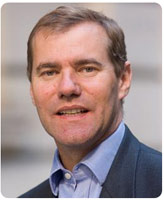NHS Direct on a mission to explain
- 29 November 2007
 |
The telephone advice service NHS Direct is now ten years old. As it matures the organisation faces new challenges and needs to respond to fresh policy imperatives.
Many clinicians, particularly GPs, continue to ask searching questions about the value of the service, and NHS Direct’s Scottish sister service, NHS 24, shows what can happen if you fail to win hearts and minds of clinicians and the public.
Fresh challenges are fast approaching with the move to local commissioning and new neighbours to learn to live with – most obviously NHS Choices, the current ministerial wunderkind.
Against this background NHS Direct appointed Matt Tee last summer, a Department of Health (DH) insider and senior communications specialist, as chief executive. Tee knows the challnges ahead having previously worked as business development director for Dr Foster – the company behind NHS Choices.
Tee has shown he can thrive in the rarified air at the top of the NHS and DH. He joined NHS Direct following two years as head of communications for the DH. Before this he was business development director for Dr Foster, a company in which he still has a “small stake." And prior to this he was director of information and analysis with the Healthcare Commission. “I’ve got pretty good networks,” admits the affable Tee.
Turning to the main challenges NHS Direct faces he says that, with the move to local commissioners and PCTs, “There is a feeling that our core service is not commissioned by them and they don’t have control over it. Why would they be interested or want to engage?” he asks.
Dispelling myths about NHS Direct
In part this is due to “myths” about the telephone advice service, he says. “GPs’ perceptions are often that what NHS Direct does is raise expectations.” To counter this common, but mistaken, view he says NHS Direct must “engage with commissioners” and “better integrate with other parts of the NHS”, particularly on urgent care and the portfolio of uncheduled services.
“With GPs we need to have a better evidence-based story on what impact we have,” says Tee. “Fifty percent of calls into NHS Direct do now result in self-care and pharmacy advice.” Summing up, he says there is an imporatnt piece of work to be done “going out and dealing with with the difficult assumptions”.
He says that that big changes are also planned in the structure of NHS Direct. "We are already a trust and hope to become a Foundation Trust next year,” Tee tells EHI. “This throws up all kinds of issues for us and ministers.” Among them are: what does public membership look like for NHS Direct as an FT? Who would the shareholders be?
Future use of technology by NHS Direct
He says social network technologies will have a key role to play in engaging stakeholders. “The intention is there as we are a technology agency we want to make use of Web 2.0 developments to engage with members."
Because NHS Direct would have the largest FT membership, Tee said the organisation would have to make use of technology to handle communications. “As a technology based organisation our preference is to communicate electronically. We’re looking to go beyond e-mail. It needs to be a way of interacting with people who use our service”.
The aim, though, is not to duplicate already popular services. He recounts how Paul Corrigan, Tony Blair’s health advisor, wisely helped discouraged plans by the Department of Education to set up its own version of Mums.net. “We don’t want to duplicate what is already working”.
“We do see ourselves as a technology organisation,” says Tee. “The full use of technology to support impoved healthcare has barely been explored yet. I want to see NHS Direct go far beyond being a reactive health and advice service.”
He says he wants NHS Direct to be a “good partner”, helping people make sense of healthcare for patients. “Not forgetting that what that technology does is to enable the health service.”
Connecting to the Spine in 2008
Tee describes the relationship with Connecting for Health as “a very contructive working relationsip”. He says that HealthSpace – the personal health record project begun by NHS Direct and then moved to CfH – continues to be a core area of collaboration.
Currently Tee says the most important subject of discussion is when NHS Direct will connect to the NHS Spine. “I’m hoping that we will connect to the Spine in 2008.” What is not clear yet, is whether this will just be around demographics, says Tee. This, he says, will be instrumental for NHS Direct becoming fully integrated into the healthcare system, so GPs know when their patients contacted the service and have access to the record of symptoms described and advice given.
Tee says that NHS Direct has over seven million patient records, which will be integral to ensuring the Summary Care Record [SCR] becomes as useful as possible to clinicians. “I’m keen to get to a point with the SCR that GPs will be able to see details of patients that have seen the out of hours service.”
NHS Choices and NHS DIrect
Asked about whether NHS Direct was now having to compete with NHS Choices, which now offers online self-help guides and advice, Tee says: “NHS Choices is embryonic but is making a good start as the web-place you go to for information on health services.”
The future relationship between NHS Direct and NHS Choices will, he says, partly be determined by the £80m NHS Choices procurement now out to tender.
Asked whether NHS Direct itself will bid, Tee tells EHI: “I don’t know whether NHS Direct can bid, we wish to have an involvement and are in discussion with the Department of Health.” The NHS Direct boss adds: “I’m very clear we have some expertise in the area that is Choice.”
At its core, he says NHS Direct is about “offering symptomatic advice to patients”, provided both online and by expert advisors. The next steps of development are making these services seamless. “So if you are following a web self-help guide you don’t just see a number to call but can click on a button to make the call.”
However, Tee says there is an overlap in between the services. “Some of the things we provide could become a Choice product like the NHS Encyclopedia.”
Accelerating the take-up of choice
Tee told EHI that the starting point for NHS Choice had been the “degree of frustration by ministers about the fragmentation of patient information from multiple information sources”. This was seen as partly responsible for the slow take-up of choice by patients. “The take-up of choice was slower than had been hoped for.”
Referring to the other NHS agencies responsible for patient information, including provider performance, Tee says the record has been mixed. “If you look at the Healthcare Commission and Information Centre and Audit Commission you have a bunch of people who have information on service performance and clinical performance but don’t do it well for patient use.”
He says NHS Direct “has never aspired” to get into providing information on services and performance, while Choices “don’t want to get into symptomatic advice or calls”. But he also says the future is uncertain. “Right now we’re still at the discussion stage with NHS Choices. We and the DH are working out what a sensible division is. I don’t feel we are facing competition or are under threat.”
NHS Direct brand as strong as Stella
He added: “NHS Direct comes with 10-years offering information and advice. For us its about those areas. We have a very, very strong strong brand, surveys put our brand strength at the same level as Stella Artois.”
Although NHS Direct has now been running for a decade, Tee says it is only in the last three or four years that it has been pulled together as a common organisation, with common software and platform. “I do think we come to the party with 10 years of technological know-how and experience.”
Jon Hoeksma




